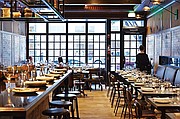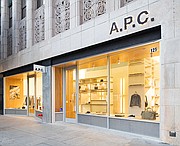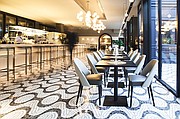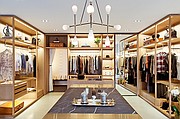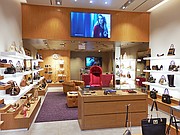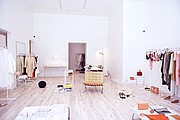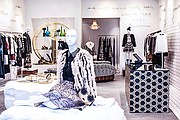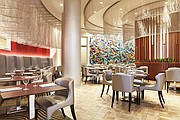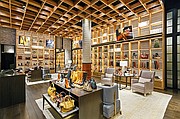TRADE SHOWS
Trade Show: Shop & Dine
Hours spent inside an exhibition hall or wandering the corridors of a showroom building can take its toll with lack of sunshine, too many people and not enough to eat.
That’s why, at the end of the day, it’s a wonderful pleasure to discover a new restaurant or shop that rewards you for all those hours put in trying to make that sale or discover that new clothing collection.
Here are a few suggestions on some of the newer restaurants and fashionable boutiques found in the major cities on the trade-show circuit.
LOS ANGELES
Little Sister
523 W. Seventh St.
(213) 628-3146
Little Sister is the newest addition to an area in downtown Los Angeles becoming known as restaurant row.
The compact space, which fits 50 diners, is extremely cozy, with twinkling candles on each table and a view of the pedestrian traffic passing by on Seventh Street, across the street from the ever-popular Bottega Louie.
Little Sister is the downtown branch of a restaurant by the same name in Manhattan Beach, that seaside community in Los Angeles’ South Bay where housing is as expensive as in Santa Monica.
Jed Sanford and Tin Vuong, who grew up in the San Gabriel Valley, founded the dining endeavor and garnered rave reviews for their Manhattan Beach eatery. So they decided to extend their blend of Southeast Asian food to the downtown area, which is booming with new residents.
Little Sister opens early for breakfast and stays open for lunch and dinner. The breakfast lineup has items such as Chinese donuts and congee. Lunch has Vietnamese sandwiches, and dinner is filled with plates that take their cue from South Korea, Vietnam and Myanmar.
Diners rave about the shaky shaky beef served with tomato garlic rice or the grilled baby octopus with walnuts and black garlic aioli. Also on the menu are things such as papaya salad, Vietnamese crêpes and Myanmar okra curry.
Other favorites include the salt-and-pepper lobster served with butter-fried shallots, the Vietnamese roasted chicken and the spicy pork dumplings.
Make reservations because the restaurant is popular and fills up fast for lunch and dinner.
A.P.C.
125 W. Ninth St.
(424) 252-2762
A.P.C. founder Jean Touitou has a tradition of launching stores in offbeat locations and spearheading geographical retail shifts, and the recent openings of the A.P.C. stores in downtown Los Angeles and Silver Lake are part of the French retail chain’s commitment to expanding U.S. business. The two newest stores join the French clothier’s longstanding Los Angeles store in Melrose Place.
The 1,500-square-foot downtown store houses men’s and women’s ready-to-wear collections—via separate entrances—under one roof. The design concept of the store divides the space into two identical and adjacent cubic spaces. Where the two areas partially meet there are two central “totems,” made from an assembly of wooden tubes covered with translucent panels. The totems function as support for the collections as well as light boxes. A large vertical, translucent screen anchors the bottom of the totems and separates the two fitting rooms. The two entrances are kept separate and are visually united by a common façade, which displays two large, identical glass frames, open to the city.
Located two blocks west of LA’s Fashion District and one block north of the hip Ace Hotel, the boutique is part of a growing retail district that includes Acne Studios, Tanner Goods and the newly opened BNKR boutique.
NEW YORK
La Sirena
88 Ninth Ave.
(212) 977-6096
The dynamic duo of Mario Batali and Joe Bastianich hadn’t opened a new eatery in Manhattan for the last 10 years, but they broke that dry spell with a large, airy restaurant that debuted early this year on the plaza level of the Maritime Hotel.
The sea is the theme at La Sirena, which means mermaid in Italian or Spanish. That seems an appropriate name for a restaurant housed in a building with porthole windows that years ago was the hiring hall for the National Maritime Union. Since 2003, it has been a hotel in the Chelsea district of Manhattan.
La Sirena is huge—with two dining rooms that can seat 100 people in each one. During the summer months, an outdoor area that also accommodates 100 people is open to enjoy the night breezes.
The décor is definitely more in the style of the 1960s with a custom Portuguese-style tile floor whose undulating black-and-white designs are reminiscent of sea waves. A 38-foot-long marble bar separates the two eating areas, which are open for breakfast, lunch and dinner.
Batali has been busy opening restaurants around the country and expanding his Eataly model to other cities. He is also one of the hosts of the ABC-TV cooking show “The Chew.”
But he and Bastianich—whose other Manhattan restaurants include Luppa, Babbo and Del Posto—jumped back into the restaurant-building mode when approached by the owners of the Maritime Hotel.
The menu is rich with Italian-style seafood and red-meat dishes. Appetizers start with items such as roasted asparagus and crispy soft shell crab, charred quail with red mustard greens.
Salads include a frisée combination with a poached egg, warm pepperoni and potatoes; a three-colored salad with Chianti vinaigrette; and a mixed green salad.
Naturally, there are plenty of pasta dishes including Bucatini La Sirena—a thick spaghetti noodle with a hollow center served with octopus—tonnarelli served with lobster and lemony bread crumbs, and semolina pasta served with veal tripe and celery.
Main dishes are very country European with fried rabbit served with a white bean ragu, duck rubbed with Moorish spices, Sicilian-style swordfish and grilled lamb chops with chickpea-flour fritters.
Tags
262 Mott St.
(212) 775-8244
Bringing a little California to the Big Apple with handpicked brands such as Mother, J Brand, Frame,Equipment, LNA and Cotton Citizen as well as a slew of Aussie labels, Tags Boutique just opened its second U.S. location in February.
“I had been looking into expanding to New York for a while since we have so many New Yorkers as customers already when they visit LA,” said owner Jackie Rose. “As soon as I found the space in the up-and-coming neighborhood of Nolita [North of Little Italy], I knew I had found what I was looking for.”
The original Tags boutique in West Hollywood has a spacious, modern look that is ever changing with the seasons and new merchandise. For the New York store, Rose commissioned design firm Crème Design, based in Brooklyn, to give the East Coast store a completely different aesthetic. Everything in the New York store was custom built, giving the 650-square-foot space the familiarity and warmth of a friend’s coveted walk-in closet. But don’t be fooled by the size of the store. With new merchandise on the racks weekly, there is always something new and exciting to shop.
In its new neighborhood, Tags joins the likes of Margaret O’Leary, across the street, and Rebecca Taylor, located a few doors down the street.
LAS VEGAS
Mr. Chow
Caesars Palace Hotel & Casino
3570 Las Vegas Blvd. S.
(702) 731-7888
Mr. Chow, the venerated high-end Chinese eatery launched nearly 50 years ago in London by artist turned restaurateur Michael Chow, has staked its latest outpost inside Caesars Palace on The Strip.
This is the seventh Mr. Chow in a collection of spots that include two locations in Southern California—Beverly Hills and Malibu—as well as restaurants in Manhattan and Miami Beach.
Mr. Chow is famous for its high-end décor, which centers around the colors black and white. The new Las Vegas restaurant holds true to that color scheme with black-and-white checked floors, white linen tablecloths and black chairs inside a contemporary-style space that overlooks the hotel’s Garden of the Gods oasis pool.
Michael Chow designed the spaceship-like sculpture that hangs from the 35-foot-high domed ceiling.
The restaurant chain is known for its Beijing-influenced cuisine that is served family style. Executive Chef Kam Kwan Chee leads the culinary team that is serving up Mr. Chow favorites such as chicken satay, green prawns, hand-pulled Mr. Chow noodles, Beijing duck and squab with lettuce.
Hors d’oeuvres include crab claws, fresh scallops and scallion pancakes. Pasta dishes range from pot stickers and Beijing meat dumplings to squid-ink rice noodles. The seafood category incorporates dishes such as steamed sea bass and Dungeness crab, and there are also some interesting meat dishes such as fiery beef and spicy pork with chili.
Carmen Steffens
3200 S. Las Vegas Blvd. #2155, Fashion Show Mall
(702) 462-5408
While it is easy to get caught up in the nonstop action for which Las Vegas is notorious, family-owned business Carmen Steffens has provided an 1,100-square-foot “oasis” in the Fashion Show Mall since opening in 2014.
“We provide a relaxing environment where visitors can explore and discover beautiful, exclusive Brazilian fashions while enjoying a glass of wine or an espresso, said Mark Willingham, Carmen Steffens president for the Northern Hemisphere. “The customer in-store experience is an integral part of our brand. We strive to provide an environment and customer experience that is unparalleled—especially at our price point.”
While their in-store customer service is noteworthy, what many people do not know is how the company has been known to make house calls for “high rollers.” The Carmen Steffens Las Vegas team certainly understands the importance of on-demand service, especially when it involves a luxe quilted backpack or sky-high stilettos.
Everything is made in-house in Brazil, with very limited quantities of each style shipped to their 550 stores in 18 countries. Until recently, Carmen Steffens’ four U.S. boutiques have only carried men’s and women’s accessories. This spring, the Las Vegas location became the first U.S. store to exclusively carry Carmen Steffens apparel.
Mario Spaniol, who founded Carmen Steffens in 1994, got his start with his own leather tannery, Couroquimica, which opened its doors in São Paulo in 1983. The tannery currently produces a monthly average of 3.2 million square feet of highly differentiated leathers, along with a variety of up to 70 prints at a time. Twenty-five percent of Couroquimica’s production is allocated to Carmen Steffens, and the rest is sold to international brands such as Hugo Boss, Timberland and Hyundai. Concerned with its environmental impact, the company has developed an on-site water-treatment plant, where 60 percent of all water used is permanently recycled.
SAN FRANCISCO
The Perennial
59 Ninth St.
(415) 500-7788
Sustainability is alive and well at The Perennial, a new restaurant by husband-and-wife team Anthony Myint and Karen Leibowitz that opened south of Market Street.
The couple is known for their other well-touted San Francisco restaurants—Mission Street Food and Commonwealth.
But for this latest endeavor, they tried to make their business as environmentally friendly and sustainable as possible. They even have a director of living systems that cares for the restaurant’s aquaponic program to grow some of its produce.
The interior of the eatery was designed with several recycled materials. The woven ceiling tiles form a canopy of California redwood, which was made from the strips shaved off support beams that once braced the ceiling of a Marin County tunnel.
The tiles are locally made at Fireclay Tile and are crafted from waste such as excess glass trimmings, curbside recycling and recycled computer monitors.
Head Chef Chris Kiyuna has the task of supporting a menu that champions progressive farming.
For example, the Kernza bread comes from a lab-bred wheatgrass that grows year-round and doesn’t need yearly planting. It grows deeper and returns carbon to the soil.
While you might think The Perennial serves only a vegetarian menu, there is plenty of meat among the carefully edited selections. There is pastured lamb, pork served with smoked yams and pearl onions, and beef served with chiogga beet and horseradish-cured root vegetables.
The trout is served with parsnips, mussels and bone-marrow broth while there is a potato confit with a clam bagna cauda.
And there is a complete bar and wine list.
Anaïse
3686 20th St.
(408) 807-9379
“I’m very much drawn to French and Italian cinema from the ’60s and ’70s,” says Renee Friedrich, founder of Anaïse. “There is something romantic, alluring and feminine about the way women dressed during this time. I imagine the Anaïse woman as a character from this period and generally pick out lines and pieces that would fit her character and life.”
Anaïse opened in 2011 as an online store and quickly built a cult-like following for its selection of hard-to-find labels in San Francisco. Opening a physical shop was always a dream of Friedrich’s. That dream came true in October, when Anaïse officially planted bricks-and-mortar roots in the vibrant Mission District.
The light-filled 1,000-square-foot flagship mixes French and Italian furniture and lighting from the ’50s to the ’70s with hints of Japanese aesthetics to create an interior with an unassuming elegance and serene boheme.
Friedrich stocks Anaïse with timeless, quality pieces from emerging and established designers from around the world. Expect to find labels such asA Détacher, Carven, Chalayan, Eatable of Many Orders, Electric Feathers, Rachel Comey, Vanessa Bruno and Veronique Leroy. And take note: The eclectic mix of accessories alone is worth a trip.
MIAMI BEACH
Klima
210 23rd St.
(786) 453-2779
It would seem only natural that Miami Beach would have a restaurant that injects a heavy dose of Spanish cuisine into the menu.
After all, it was Ponce de Leon who claimed Florida as part of Spain in 1513. Well, the Spanish are back with a great restaurant called Klima, which specializes in Catalan cuisine with touches of Italy and other Mediterranean areas.
The men behind the eatery are Spaniards Pablo Fernandez-Valdés and Yago Giner Viscasillas, who took a space off the Collins Avenue pedestrian mall and added a wow factor that is part contemporary and part Miami Beach casual.
The outdoor patio has cane ceiling sections, potted plants and subtropical greenery for a relaxing feeling. The main dining room has clean lines and an edge of warmth provided by a half dozen types of wood and marbles.
Many of the dishes on the menu come from Barcelona, that seaside city known for its Antonio Gaudí architecture, historic Barrio Gótico neighborhood and the hundreds of tapas bars that lend inspiration to Klima’s appetizers.
Appetizers include fennel-infused beef carpaccio, ham croquets, a plate of Spanish sausages or oysters with a ceviche sauce.
The main menu was recently revamped by Executive Chef Ilde Ferrer, who is now using plankton, a sort of spice of the sea, to cook some of the seafood and lend more flavor to it. The fish dishes include bacalao, hamachi, branzino and local red snapper.
The meats—such as lamb shanks, oxtail and pork ribs—are cooked in a Josper oven, a charcoal-filled oven from Spain designed to grill meats evenly.
For a touch of Italy, there is short-rib cannelloni served with a port-wine sauce, cheese ravioli with black truffle cream sauce, and fettuccine with fresh morels and cream.
Kit and Ace
219 NW 23rd St.
3401 Main Highway,
Coconut Grove
Canadian-based company Kit and Ace prefers to call its retail locations “brand showrooms,” as opposed to stores. Miami now houses two of the most recent new bricks-and-mortar establishments for the brand, which has been expanding across the U.S. with its proprietary machine-washable Technical Cashmere. The retail chain was launched by Shannon and J.J. Wilson, the wife and son of Chip Wilson, the founder of Lululemon.
Kit and Ace opened two locations in Miami at the end of 2015: one in the Wynwood Art District, and another in Coconut Grove.
The 1,511-square-foot Wynwood location does not disappoint, housing curated cultural elements among its retail therapy offerings. Because what’s a trip to Miami without a little art?
The Wynwood showroom exterior merges local tradition with the Kit and Ace design aesthetic. Designed and installed by 2 Alas, the blue-and-white exterior mural in the showroom plays on the tradition of the Wynwood walls with a Kit and Ace spin.
Inside, the shop has a classic West Coast modern feel, with Pacific gray floors, crisp white walls and “hyper-local” elements. The art elements include pieces created by Miami artists and photographers, including a large iconic photograph taken by Max Reed, titled “Building Blocks,” and a custom neon sign that reads “Time Is Precious.”
Kit and Ace already has 32 showrooms across the U.S., with 55 locations worldwide and 10 new locations slated to open later this year, including in Atlanta, Cincinnati, Washington, Detroit and New York.
“We like to show up in neighborhoods that have a curated selection of retailers and a strong creative community,” said a company spokesperson.
DALLAS
18th & Vine
4100 Maple Ave.
(214) 443-8335
Inside an old house in the Oak Lawn district of Dallas is a new restaurant that puts a different spin on the world of BBQ.
There must be enough Texas-style BBQ joints in Dallas to pave the road between Texas and Oklahoma, but not too many spots can say they serve Kansas City–style barbecue because we aren’t in Kansas anymore, as Dorothy told Toto.
Kansas City barbecue is meat that is slow-smoked over a variety of woods and then covered with a thick tomato and molasses–based sauce.
The co-owner of 18th & Vine is Matt Dallman, a Kansas guy who married a Texas woman and moved to Dallas. But Dallman missed his Kansas City–style BBQ so much that he found a smoker and learned how to cook meat the way he liked it.
He and his wife, Kim, paired up with Chef Scott Gottlich, a Dallas native, to open this eatery, which has been described as more Texas chic than down-home Texas joint.
To begin with, the interior of the restaurant—with its black leather banquettes, black wood paneling and framed photos of great jazz musicians—seems more upscale than most BBQ places. The venue was designed by Brooke Roberson Interiors and Mitchell Garman Architects.
Everyone who dines at the eatery raves about the burnt ends—an appetizer that consists of cubed brisket in a thick sauce. Other favorite starters are the fried okra and the potato skins.
Of course, meats are the specialty here with dishes such as pork chops and barbecued pork belly served with sweet potatoes and Granny Smith apples or the ever-popular pulled pork.
But there is seafood and chicken such as the smoked gulf shrimp and grits as well as the wood-kissed salmon.
Believe it or not there is a vegetarian option—cauliflower steak.
Alice + Olivia
7 Highland Park Village,
Suite 7B
(972) 426-7364
Alice + Olivia’s 1,313-square-foot Highland Park Village store is the brand’s 17th domestic retail store but the first stand-alone location in Texas. With a prime position in the luxury shopping center, the store, which opened this past October, offers customers an intimate and whimsical shopping experience showcasing the brand’s complete product offering each season.
The store’s interior takes inspiration from the brand’s ethos in a fresh perspective, with subway-tiled walls, cement floors and black and white–striped drapes.
Since the Dallas store has opened, it has commissioned a series of in-store, pop-up installations by local Dallas artists as a special tribute to the region. The project kicked off with Rebecca Carter’s “Loosed Words,” which covered the store’s interior walls with the artist’s texts. The second installation, with artist Sergio Garcia, pulled inspiration from the Alice + Olivia designer Stacey Bendet herself to create a custom “Stace Face” tricycle in the artist’s signature style. The most recent pop-up, which is currently running, includes a sculptural gown installation by Letitia Huckab.
“We are so excited about our first retail store in [Dallas]. Our vast offering from casual chic to formal will be the perfect complement to the social calendar of this vibrant city,” said Deanna Berkeley, president of Alice + Olivia by Stacey Bendet.
Highland Park Village is an upscale shopping plaza located at the southwest corner of Mockingbird Lane and Preston Road in the Dallas suburb of Highland Park, which bills itself as the first self-contained shopping center in America. Other recent retail additions to Highland Park Village include Celine and Etro.
ATLANTA
JP Atlanta
230 Peachtree St. NE
(404) 523-4004
Renowned Atlanta architect John C. Portman Jr., known for developing many of the buildings in downtown Atlanta’s Peachtree Center, may be in his 90s but he isn’t retiring his architectural skills.
He and his team recently undertook a massive project to convert an office building he designed decades ago into an upscale hotel, office space and a new restaurant called JP Atlanta, which opened in late 2015 inside the new Hotel Indigo Atlanta Downtown. The complex is attached to the AmericasMart, which Portman’s firm completed in 1961.
Portman injected sleek colors into the interior design of the eatery, with tall silvery columns and matching silvery chairs. A round canopy tops the circular bar and a swirl of colors carpets some of the walls.
The restaurant draws inspiration from Portman’s previous restaurant, called The Midnight Sun, which operated in the downtown area between the 1960s and the 1980s.
Hired to guide the menu was Executive Chef Julio Delgado, a native of Puerto Rico who has years of experience at several high-end Atlanta restaurants.
Delgado draws on local farms for his ingredients, which make up his modern cuisine, redeveloped classic dishes from the 1960s.
Small dishes include white asparagus cream soup, crab rolls, a spicy vegetable salad, grilled octopus and grilled red shrimp.
Main dishes are standards with a twist. The roasted pork loin is served with sun chokes, blackberries and mustard greens. The lamb leg is accompanied with smoked apricots, artichokes and black garlic. The beef rib eye comes with trumpet mushrooms, new potatoes and beef jus.
The seared scallops are served with zucchini squash and carrot lobster sauce, and the spring trout comes with cauliflower, navel oranges and caper butter.
The restaurant is open for breakfast, lunch and dinner.
The Frye Company
675 Ponce De Leon Ave. NE
(404) 685-3793
The Frye Company’s Ponce City Market retail store opened in August 2015 and has already garnered much attention, including earning The Retail Design Institute Award for Best Soft-Line Specialty Store in the footwear category for 2016.
Housed in the historic Sears Roebuck distribution center—originally built in 1926—the Frye Company’s 4,000-square-foot store is on the center’s main level arcade. The storefront replicates the warehouse windows seen above the main level.
Based on Frye Company’s heritage steeped in American craftsmanship, the Atlanta store highlights the brand’s legacy through a celebration of authentic products and iconic leather goods. The space showcases the breadth of the brand’s footwear and accessories for men, women and children, maintaining the tradition of quality and craftsmanship that has been a hallmark of The Frye Company.
The store’s most dramatic feature is an enormous installation known as “The Chandelier,” which consists of 7,000 leather straps holding Frye Company’s signature harness rings. Surrounding The Chandelier are shelving units inspired by a craftsman’s toolbox from the turn of the century. The toolbox units have been redesigned to work as shelving within the stores “workshop” and display “The Archive,” a curated grid wall of handbags, which coordinate back to the footwear.
The store draws inspiration from vintage artisan workshops, incorporating details in the furniture, lighting and displays. Raw materials used throughout the store are left to weather, with the assertion that each becomes better with age, just like its products. Tables designed to reference workbenches coexist with custom seating in gray upholstery accented by bronze legs and vintage carpets.
The curated environment, designed by Frye Company’s in-house team, in partnership with Carlton Architecture of New York, captures the spirit and essence of the brand’s 153-year history while incorporating unique characteristics of the locale. The store has a distinct character, conveying a sense of warmth and familiarity via a sensory journey of rich leathers, craftsmanship and history.
